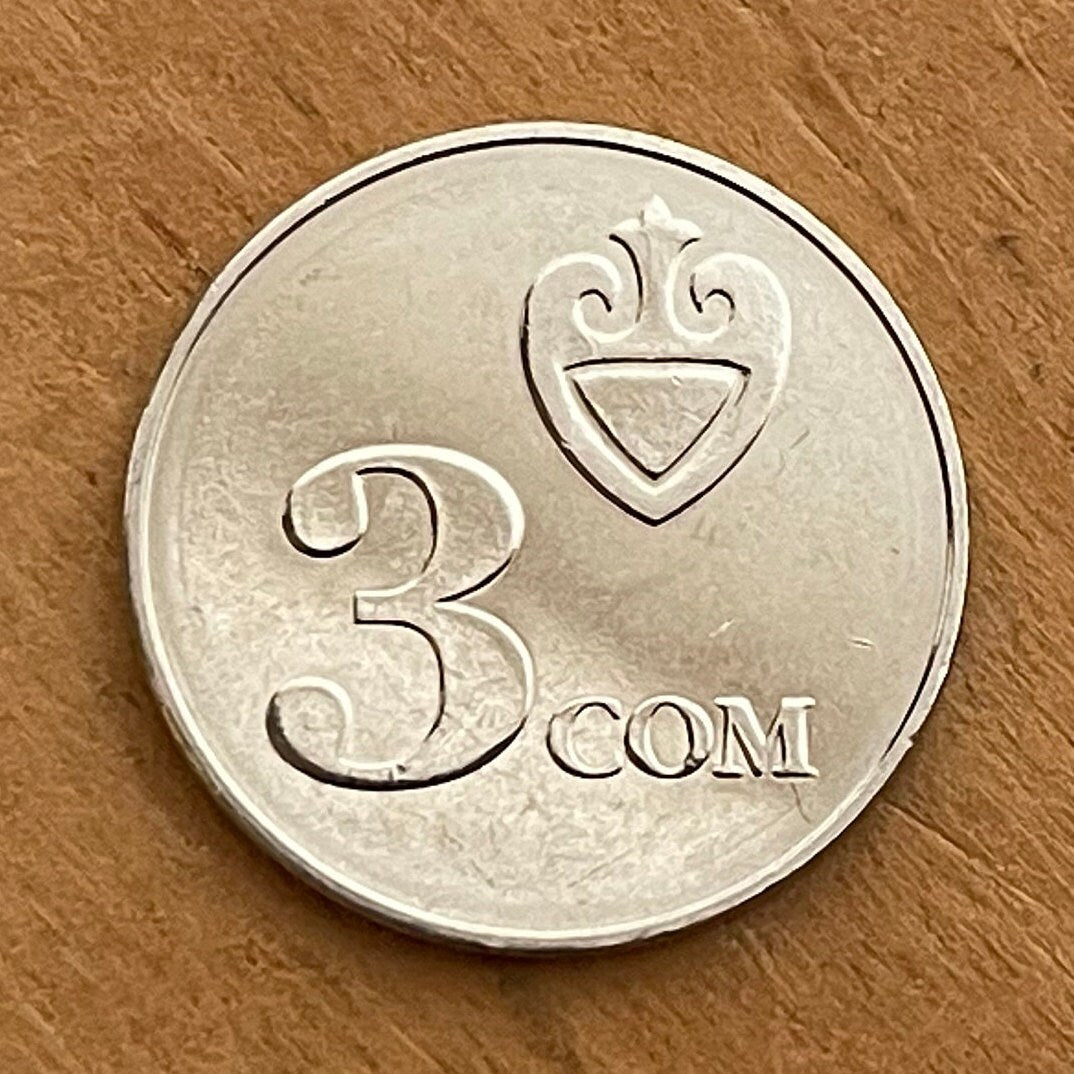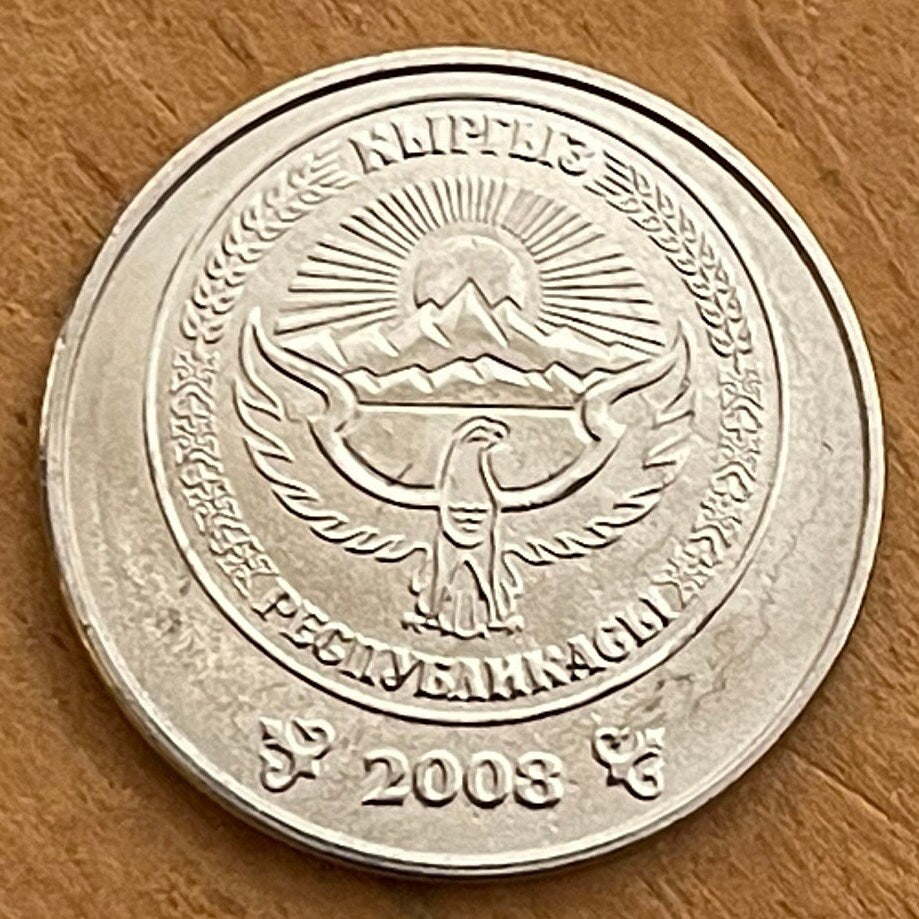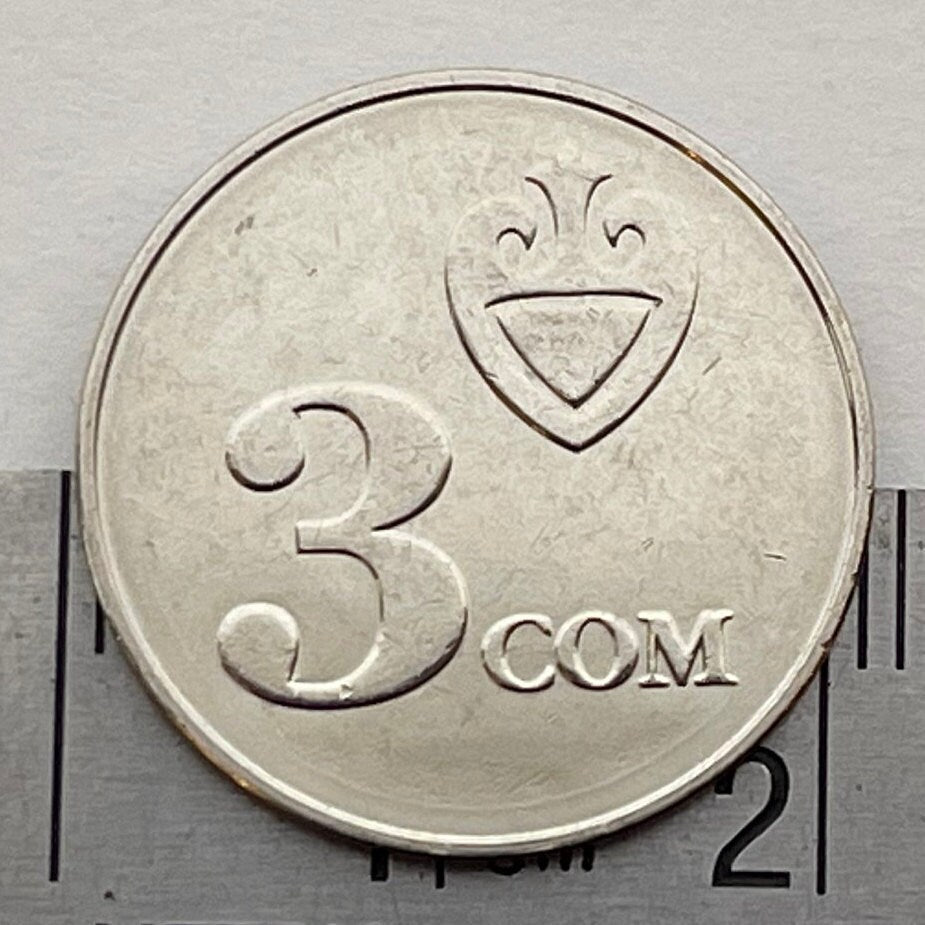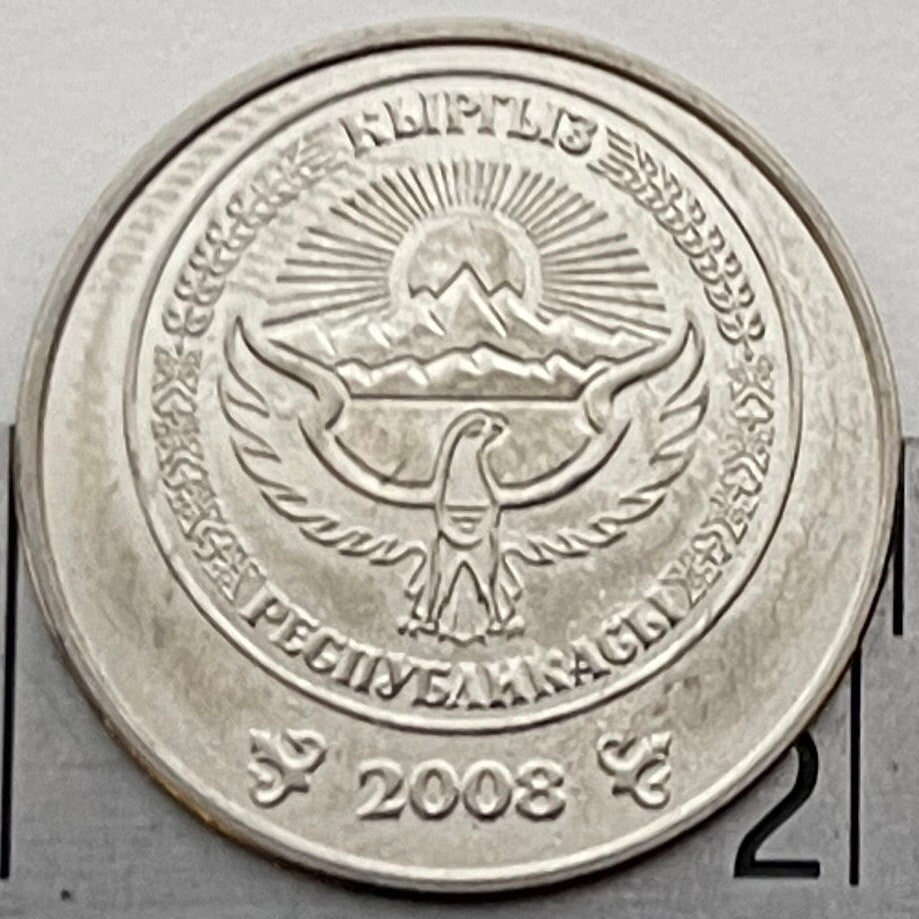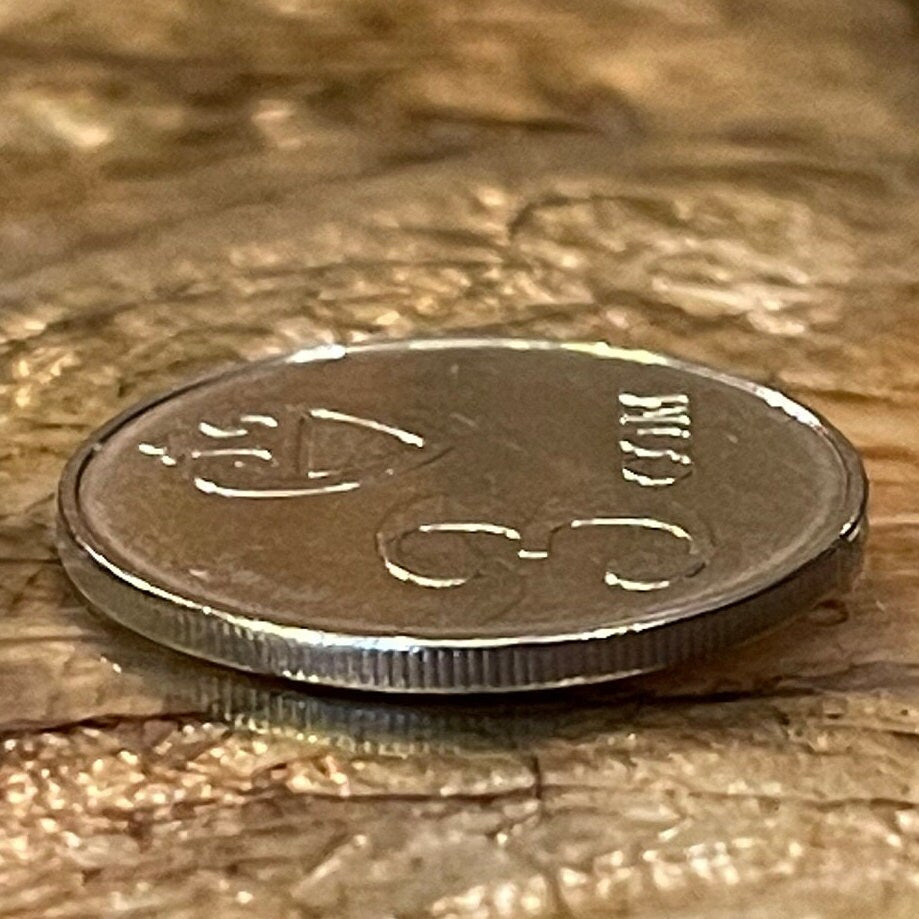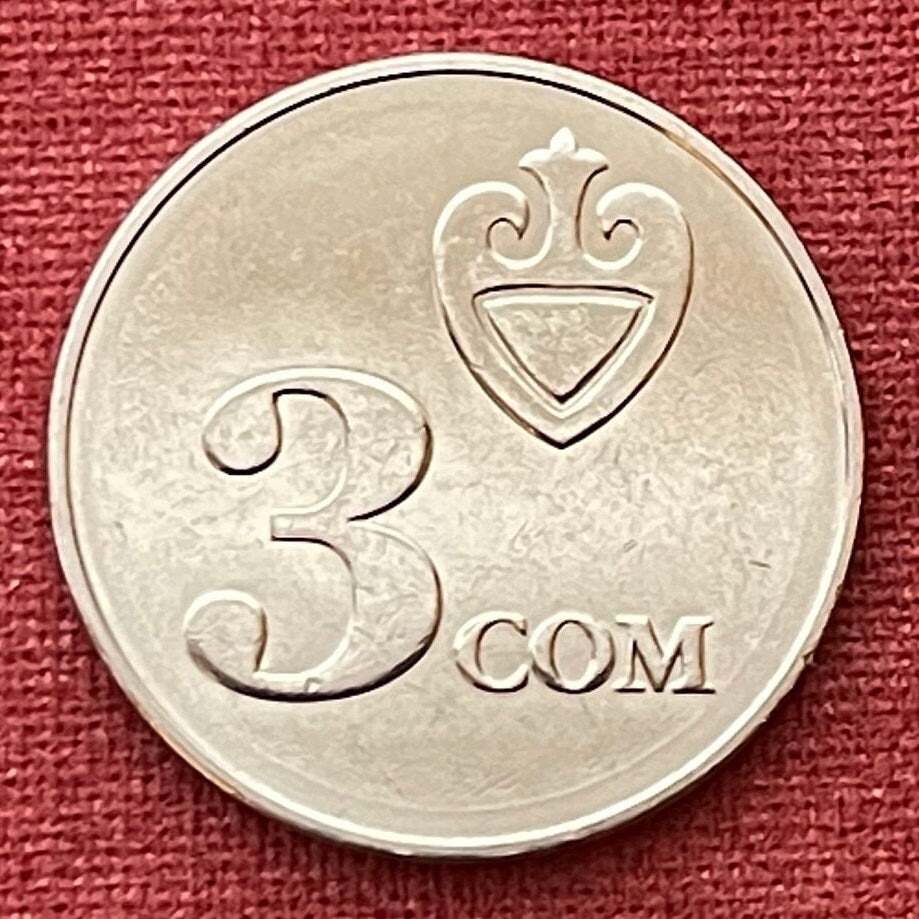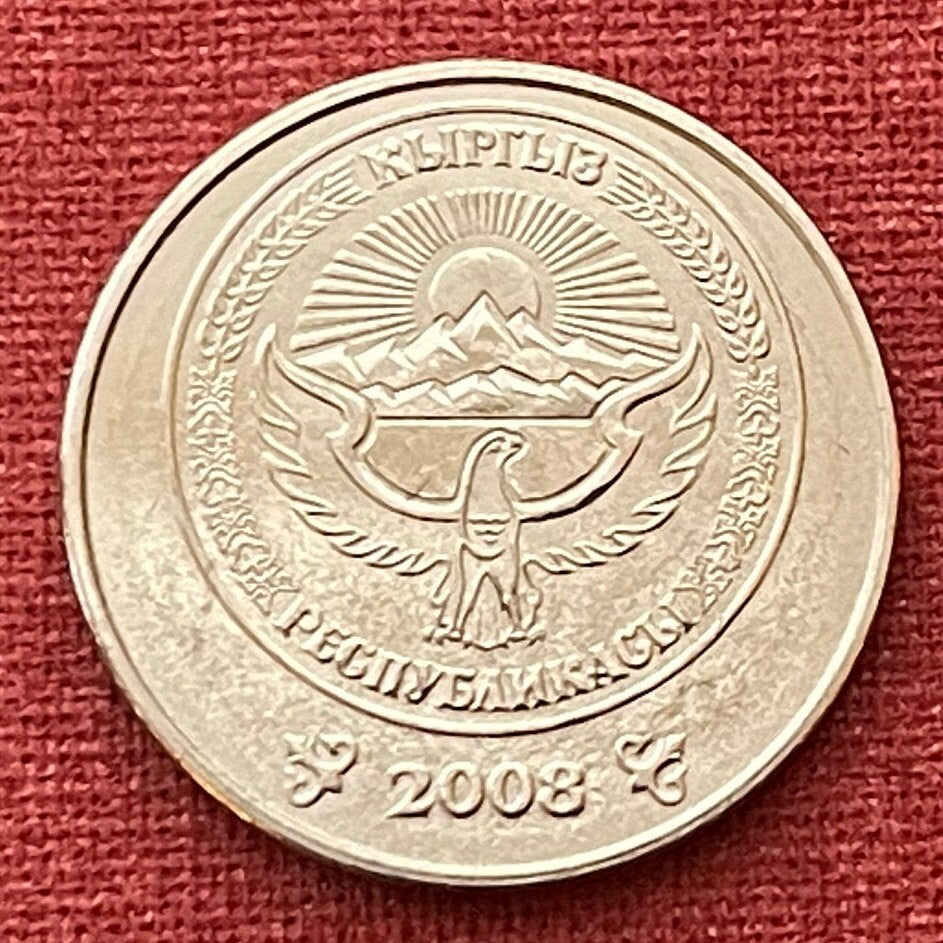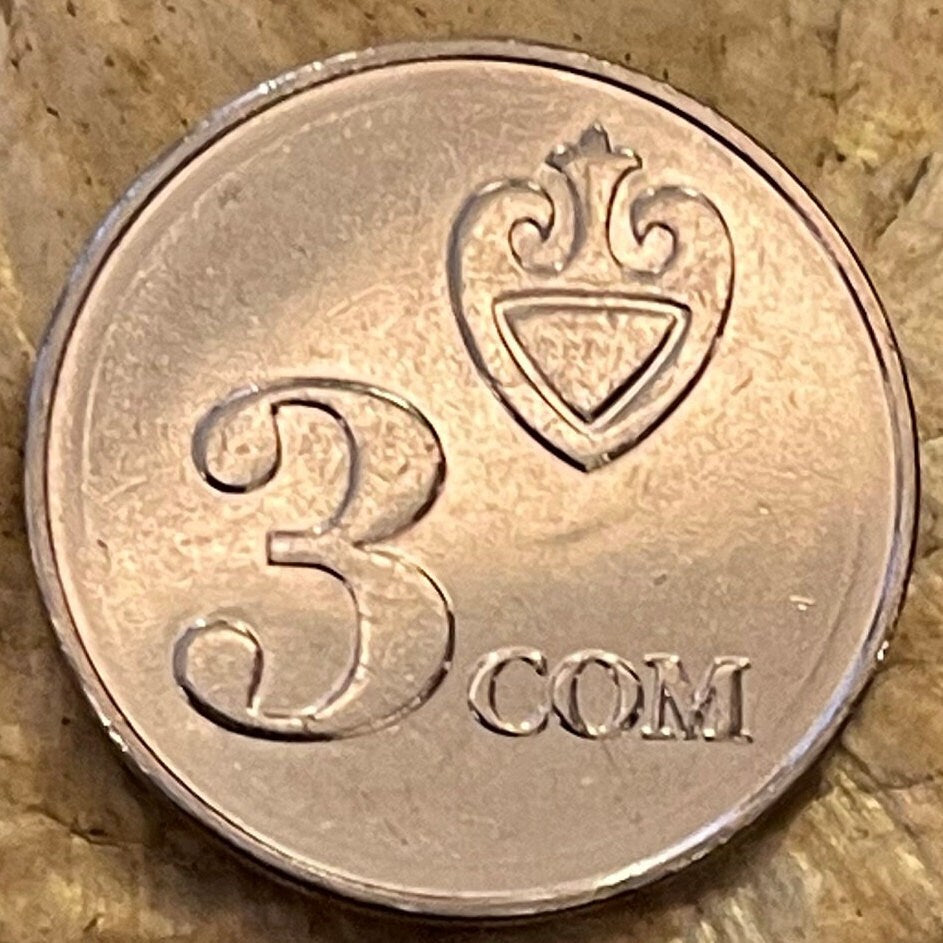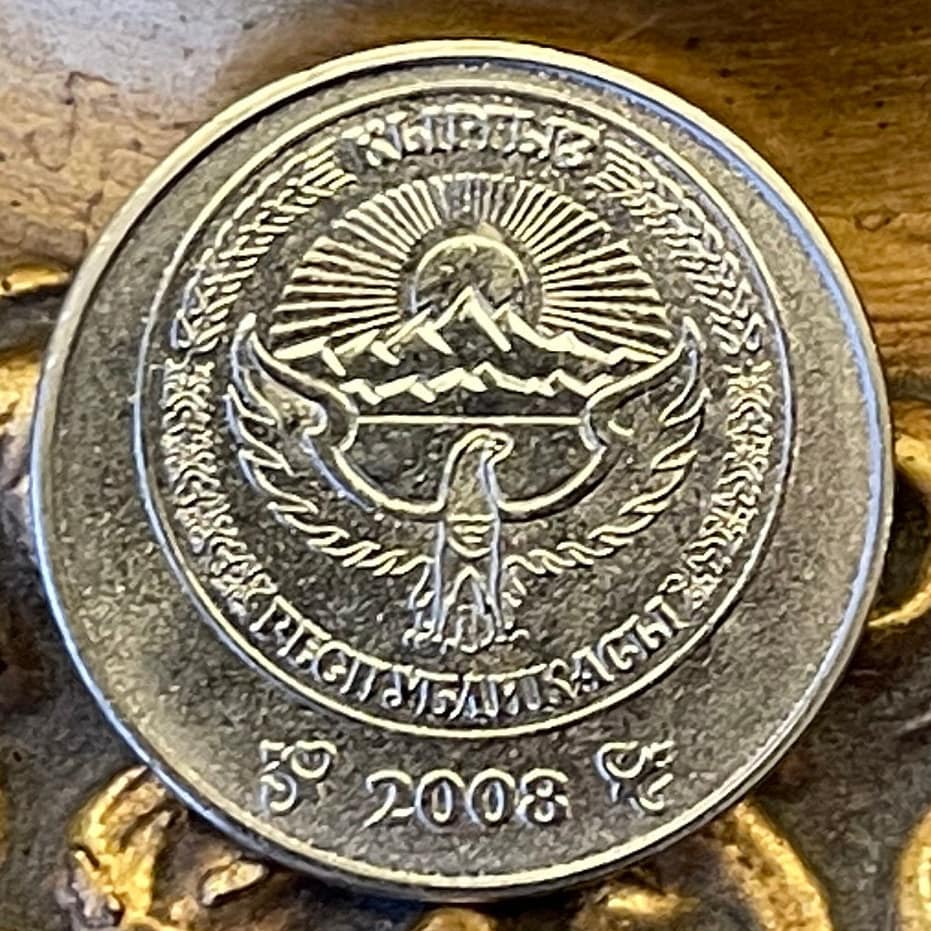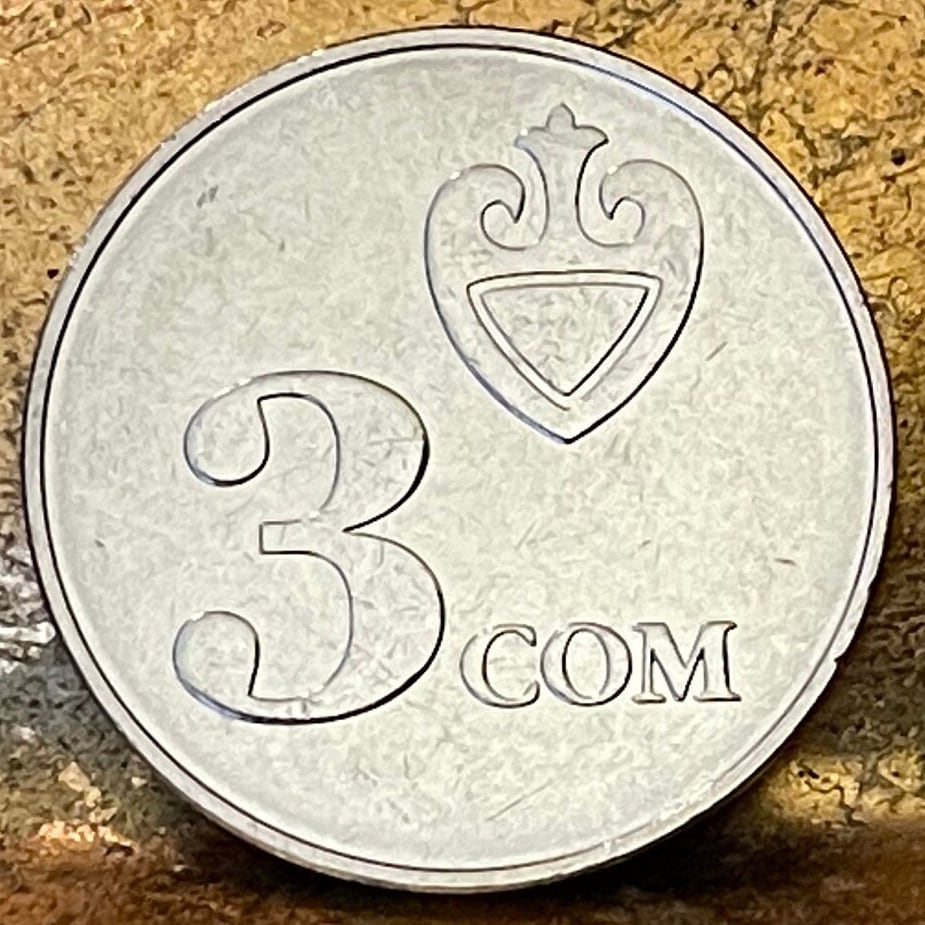elemintalshop
Köökör for Kymyz Mare's-Milk with Tumar Triangle Charm & White Falcon and Tian Shan Mountains 3 Som Kyrgyzstan Authentic Coin (Luck) 2008
Köökör for Kymyz Mare's-Milk with Tumar Triangle Charm & White Falcon and Tian Shan Mountains 3 Som Kyrgyzstan Authentic Coin (Luck) 2008
Couldn't load pickup availability
Köökör for Kymyz Mare's-Milk with Tumar Triangle Charm & White Falcon and Tian Shan Mountains 3 Som Kyrgyzstan Authentic Coin Money for Jewelry and Craft Making (Ak Shumkar) (Issyk Kul) (Ala Too) (Tian Shan) (Tengrism) (Good Luck) (Kumis)
Reverse: Köökör, a traditional Kyrgyz thermos-like container made of leather, for carrying Kymyz, the traditional fermented mare's-milk drink. The köökör image on the coin bears, on its front, a triangular good luck symbol called "Tumar".
Lettering: 3 COM
Translation: 3 Som
Obverse: Coat of Arms of the Kyrgyz Republic and the year when the coin was issued. Depicted are the legendary Ak Shumkar white falcon, which spreads its wings over Issyk-Kul Lake, in front of Teñir Too (Tian Shan) mountain peaks, beneath rising sun with 40 rays symbolizing legendary 40 clans of Manas.
Lettering: КЫРГЫЗ РЕСПУБИКАСЫ
2008
Translation: Kyrgyz Republic
2008
Features
Issuer Kyrgyzstan
Period Republic (1991-date)
Type Standard circulation coin
Year 2008
Value 3 Som
3 KGS = USD 0.038
Currency Som (1993-date)
Composition Nickel plated steel
Weight 3.2 g
Diameter 21 mm
Thickness 1.4 mm
Shape Round
Technique Milled
Orientation Medal alignment ↑↑
Number N# 5008
References KM# 15, Schön# 19
KÖÖKÖR
Köökör is a type of leather container that preserves the ancient Kyrgyz national drink. It was used to keep kymyz. To make it, the craftsmen made the skins of cows and camels and engraved the national symbol on the outside. It is also one of the most beautiful of these leather containers.
There are regional differences in the capture of kookor. For example, it would shave the skin of a freshly sheared cow and put it in a pot.
After three or four days, it will be very soft. After removing it from the pot, it is cut and sewn on that soft. It is filled with sand, and when it swells, it is decorated with a broken horn picture. The skin dries on the sand inside.
Camel skin is thick. After defrosting, it is usually shoveled. It sews the outer part of the skin, which is cut into bruises, separately, and the inner part of the flesh with a separate seam. After giving it a bluish texture, they put soil, sand, and often sand-mixed soil into the skin.
Craftsmen make different sizes of kookors. The largest is filled with six to eight liters of liquid, and the smallest with one and a half liters. Kookors are made in different shapes and decorated with different ornaments. The carvings or ornaments on it are mainly "curved", "horn", "dream", "half dream".
Most kookors have a narrow mouth, a long neck, a broad base, flat shoulders and shoulders. Jewelers embroidered silver, copper, bronze, and tin on the corners, shoulders, and neck of the kookor.
The fact that the kookor must be at the edge of the table and poured kymyz from it to the guests, it was a testament to the politeness and kindness of our people. It is also necessary to smoke once or twice a year, because it always maintains a strong condition. Today, kookors are used by our contemporaries as keychains and souvenirs.
Source: https://yurtcampalay.kg/en/2021-04-02-18-05-5/10-kyrgyzclothes.html
********
Wikipedia:
Kumis (also spelled kumiss or koumiss or kumys)... is a fermented dairy product traditionally made from mare milk or donkey milk. The drink remains important to the peoples of the Central Asian steppes, of Turkic and Mongol origin: Kazakhs, Bashkirs, Kalmyks, Kyrgyz, Mongols, and Yakuts. Kumis was historically consumed by the Khitans, Jurchens, Hungarians, and Han Chinese of North China as well.
Kumis is a dairy product similar to kefir, but is produced from a liquid starter culture, in contrast to the solid kefir "grains". Because mare's milk contains more sugars than cow's or goat's milk, when fermented, kumis has a higher, though still mild, alcohol content compared to kefir.
*******
History of The Tumar Good Luck Charm
These amulets traditionally held prayers from the Koran and were worn to keep the wearer safe. The Tumar is now used as a gift item and people give them to let others know that they are thinking of them and wishing them happiness, luck and good health. When a child is born, they are gifted a Tumar to keep close to them and bring them luck.
Why the Tumar Charm Brings Luck
Tumars are believed to bring good luck as they hold either a prayer by a Shaman or can even have soil from the Holy Land or salt inside the charm.
How to Make the Tumar Charm at Home
If you want to make your own version of a Tumar you should choose a material that is simple to use; ideally cloth or leather.
Firstly, cut out two Tumar shaped pieces and then sew them together – leaving a tiny gap to put your chosen filling in. Traditionally, Tumars hold soil or salt from the Holy Land but you may wish to put a secret message of luck inside yours to give to a friend or loved one. Sew up the remaining hole and then attach the Tumar to your chosen chain – you can do this by applying material glue or by making chain holes to fit the chain through. Tumars are typically given to new-born babies and can contain prayers from the Koran to keep them safe and sound.
Source: https://lucky-charms.org/kazakhstan-good-luck-charm-tumar/
*****
From Wikipedia:
The Kyrgyz Emblem is in a circle which, in the conventional language of symbols, expresses the mentality, nature, culture and management of the Kyrgyz people.
In the foreground is a frontal image of a white falcon with wings wide open. The bird "Ak Shumkar" -- a symbol of purity and nobleness of thoughts -- is sung in legends and folk epics. The bird means a way of life, the traditional culture of the Kyrgyz people and symbolizes the protection of the Kyrgyz land, stretching behind it, with Issyk-Kul Lake and the snowy peaks of the Kyrgyz Ala-Too mountains (especially the Tian Shan peaks).
In the depths of the circle, beyond the mountains, the sun rises, golden rays shining on the sacred land of Kyrgyzstan. the forty rays that extend from it refer to the legendary forty clans of Manas.
The decorative frame in the form of a ribbon strip giving the necessary information: the word “Кыргыз” (Kyrgyz) is located in the upper part, and “Республикасы” (Republic) in the lower part.
The sides of the frame contain decor, composed of motifs of the ornament, stylized opened cotton bolls, ears of wheat - the main cultivated crops on Kyrgyz soil.
******
Wikipedia:
Issyk-Kul (also Ysyk Köl, Issyk-Kol, Kyrgyz: Ысык-Көл, Isıq-Köl, ىسىق-كۅل, [ɯsɯqkœl]; Russian: Иссык-Куль, Issyk-Kulj) is an endorheic lake in the Northern Tian Shan mountains in Eastern Kyrgyzstan. It is the seventh deepest lake in the world, the tenth largest lake in the world by volume (though not in surface area) and the second largest saline lake after the Caspian Sea. Issyk-Kul means "warm lake" in the Kyrgyz language; although it is surrounded by snow-capped peaks, it never freezes.
******
Wikipedia:
The Kyrgyz Ala-Too (Kyrgyz: Кыргыз Ала-Тоосу, Kırgız Ala-Toosü, [kərˈɣəs ɑlɑˈtoːsu]; Kazakh: Қырғыз Алатауы, Qyrǵyz Alataýy) also known as Kyrgyz Alatau, Kyrgyz Range, and Alexander Range (until 1933) is a large range in the North Tien-Shan. It stretches for a total length of 454 km from the west-end of Issyk-Kul to the town Taraz in Kazakhstan. It runs in the east-west direction, separating Chuy Valley from Kochkor Valley, Suusamyr Valley, and Talas Valley. Talas Ala-Too Range adjoins the Kyrgyz Ala-Too in vicinity of Töö Ashuu Pass. The western part of Kyrgyz Ala-Too serves as a natural border between Kyrgyzstan and Kazakhstan.
*******
Wikipedia:
The Tian Shan, also known as the Tengri Tagh or Tengir-Too, (Old Turkic: 𐰴𐰣 𐱅𐰭𐰼𐰃 , Uyghur: تەڭرىتاغ , Chinese: 天山) meaning the Mountains of Heaven or the Heavenly Mountain, is a large system of mountain ranges located in Central Asia. The highest peak in the Tian Shan is Jengish Chokusu, at 7,439 metres (24,406 ft) high. Its lowest point is the Turpan Depression, which is 154 m (505 ft) below sea level.
One of the earliest historical references to these mountains may be related to the Xiongnu word Qilian (simplified Chinese: 祁连; traditional Chinese: 祁連; pinyin: Qí lián) – according to Tang commentator Yan Shigu, Qilian is the Xiongnu word for sky or heaven. Sima Qian in the Records of the Grand Historian mentioned Qilian in relation to the homeland of the Yuezhi and the term is believed to refer to the Tian Shan rather than the Qilian Mountains 1,500 kilometres (930 mi) further east now known by this name. The Tannu-Ola mountains in Tuva has the same meaning in its name ("heaven/celestial mountains" or "god/spirit mountains"). The name in Chinese, Tian Shan, is most likely a direct translation of the traditional Kyrgyz name for the mountains, Teñir Too. The Tian Shan is sacred in Tengrism, and its second-highest peak is known as Khan Tengri which may be translated as "Lord of the Spirits". At the 2013 Conference on World Heritage, the eastern portion of Tian Shan in western China's Xinjiang Region was listed as a World Heritage Site. The western portion in Kazakhstan, Kyrgyzstan, and Uzbekistan was then listed in 2016.
*****
Wikipedia:
Tengrism (also known as Tengriism, Tengerism, or Tengrianism) is an ancient ethnic and state Turko-Mongolic religion originating in Central Asia and the Eurasian steppes, based on folk shamanism, monotheistic at the imperial level, and generally centered around the titular sky god Tengri. The term also describes several contemporary Turko-Mongolic native religious movements and teachings. All modern adherents of "political" Tengrism are monotheists.
It was the prevailing religion of the Turks, Mongols, Bulgars, Xiongnu, Huns, and, possibly the Magyars, and the state religion of several medieval states: Göktürk Khaganate, Western Turkic Khaganate, Eastern Turkic Khaganate, Old Great Bulgaria, Danube Bulgaria, Volga Bulgaria, and Eastern Tourkia (Khazaria). In Irk Bitig, a ninth century manuscript on divination, Tengri is mentioned as Türük Tängrisi (God of Turks). According to many academics, Tengrism was a predominantly polytheistic religion based on shamanistic concept of animism, and during the imperial period, especially by the 12th–13th centuries, Tengrism was mostly monotheistic.
Tengrism has been advocated in intellectual circles of the Turkic nations of Central Asia (Kyrgyzstan with Kazakhstan) and Russia (Tatarstan, Bashkortostan) since the dissolution of the Soviet Union during the 1990s. Still practiced, it is undergoing an organized revival in Buryatia, Sakha (Yakutia), Khakassia, Tuva and other Turkic nations in Siberia. Altaian Burkhanism and Chuvash Vattisen Yaly are movements similar to Tengrism.
Tengri can either refer to the sky deity or refer also to other deities (compare this with the concept of Kami).
Tengrism is centered on the worship of the tngri (gods), Tengri (Heaven, God of Heaven) being one of them. In the Mongolian folk religion, Genghis Khan is considered one of the embodiments, if not the main embodiment, of Tengri's will.
Share
